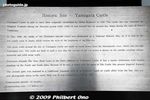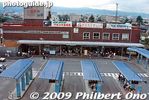Yamagata Castle (Kajo Park) 山形城・霞城公園
|
|
|

Yamagata Castle is closest to JR Yamagata Station. This is the east side. The train station and surrounding area changed a lot since my first visit years ago.
|
|

Bus stop in front Yamagata Station.
|
|

In front Yamagata Station on the east side.
|
|

In front Yamagata Station on the west side. I wonder what that prime space will be used for. The tall buildings are hotels.
|
|

On the west side of Yamagata Station is a skyscraper called Kajo Central which has also greatly contributed to the urban development of Yamagata city. A high school is in this building as well.
|
|

On the ground floor is a nice Yamagata Prefecture tourist office. Pick up pamphlets and other info here. The building is connected to Yamagata Station by a corridor.
|
|

When I was there in Aug. 2009, the lobby of Kajo Central had the interesting Art Chair Project. Elementary and intermediate school students in Yamagata Pref. competed in a design competition for art chairs, and the winners' works are displayed here.
|
|

The lobby featured chairs and benches with novel motifs. This seemed to be the most popular, sitting in a bowl of potato soup.
|
|

Grapes to sit on. Kajo Central lobby, Yamagata.
|
|

A pear perhaps.
|
|

Rice plant
|
|

Dish bench?
|
|

Kajo Central also has a lookout deck on one of the top floors.
|
|

View of Yamagata on the east side of Yamagata Station as seen from Kajo Central.
|
|

Yamagata Station
|
|

West side of Yamagata Station. Look at all that land right in front of the station.
|
|
|
|

Kajo Park as seen from Kajo Central. Kajo Park is the site of Yamagata Castle, also called Kajo or Kasumigajo Castle which means Misty Castle.
|
|

Kajo Park as seen from Kajo Central. During the Battle of Hasedo in 1600 between Mogami Yoshiaki and Naoe Kanetsugu, Yamagata Castle was hidden by mist. Hence, the nickname.
|
|

Map of central Yamagata city. The top-most road in bold leading to the former prefectural office is where the Hanagasa Matsuri parade is held in early Aug. Yamagata Castle (Kajo Park) is on the west side of the train station.
|
|

A short walk from Kajo Central is Kajo Park. You can enter the park through the South Gate or the slightly further Ninomaru Higashi Otemon Gate here. This is the main entrance. Free admission.
|
|

Southern turret on left side of Ninomaru Higashi Otemon Gate. This turret is open to the public.
|
|

Yamagata Castle's Ninomaru Higashi Otemon Gate. This gate and turret were accurately reconstructed in 1991 based on Edo Period documents and Meiji Period photos. 二の丸東大手門
|
|

Turret on right side of Ninomaru Higashi Otemon Gate. It took 3 years and 9 months and 1.1 billion yen to reconstruct the gate and turrets. It was in 1978 when they decided to reconstruct the gate and turrets. They moved and brought in many tons of stone.
|
|

Left side of Ninomaru Higashi Otemon Gate. The train line passes through.
|
|

Moat on right side of Ninomaru Higashi Otemon Gate.
|
|

About Yamagata Castle in English. Yamagata Castle was first built in 1356 by Shiba Kaneyori (斯波 兼頼) who moved to Yamagata. He became the first lord in the Mogami Clan. His most famous descendant, Lord Mogami Yoshiaki built up the castle in 1592-15
|
|

Map of Kajo Koen Park. 霞城公園
|
|

Ninomaru Higashi Otemon Gate leads to the Ninomaru keep which is a National Historic Site.
|
|

Northern turret.
|
|

Another gate at the Ninomaru Higashi Otemon Gate
|
|
|

Ninomaru Higashi Otemon Gate
|
|

The stones on the wall have cutting marks.
|
|

Behind the Ninomaru Higashi Otemon Gate is a large statue of Lord Mogami Yoshiaki.
|
|
|

Behind Ninomaru Higashi Otemon Gate
|
|

Statue of Mogami Yoshiaki who was the daimyo lord of Yamagata in the late 16th century and early 17th century. Statue constructed in 1977. 最上義光
|
|

Statue of Mogami Yoshiaki depicting him taking the lead to the battlefield against Naoe Kanetsugu. 最上義光
|
|

The park has other gates (north, south, and west) and monuments, but I didn't have time to see all of them. I exited the park through the South Gate (photos below).
|
|

Steps to the entrance of the turret.
|
|

At the top of the steps, the castle wall.
|
|
|

Inside the Ninomaru Higashi Otemon Gate turret at Yamagata Castle. Very impressive construction. Still new-looking even after almost 20 years.
|
|

They had a few exhibits and a video of the castle.
|
|
|

Slits in the floor to drop stones and arrows.
|
|

Slit in the floor to drop stones and arrows.
|
|
|
|
|

View of Ninomaru Higashi Otemon Gate's bridge.
|
|
|

Walk further and you will reach Honmaru central keep. This Honmaru bridge was accurately reconstructed in 2006.
|
|

This Honmaru bridge was accurately reconstructed in 2006. The stonework was also reconstructed in 2004. 大手橋
|
|

They want to also reconstruct buildings on the stone foundations seen here. The problem is, they don't have accurate records of what the floor plan and buildings looked like in the 18th-19th century. They are calling on the public for any old photos.
|
|

Artist's rendition of what the completed reconstruction will look like.
|
|

We can walk on the bridge to the Honmaru. 大手橋
|
|

Moat on the right side of the bridge.
|
|

Honmaru gate 本丸一文字門
|
|

This area in the Honmaru was the site of the castle palace.
|
|

They want to build an outline of the palace in the Honmaru.
|
|

Still renovating the stone walls.
|
|

Since it is a National Historic Site, the city is taking steps to revert the park into a historical site by eliminating most of the existing sports facilities (gym, baseball diamond, etc.). Should look like this.
|
|

A scale model of Yamagata Castle as it looked in the 18th century. (Displayed in the Kyodokan Museum.)
|
|

In Kajo Park is Yamagata City Kyodokan Museum that displays mainly medical-related exhibits. The building is an Important Cultural Property. 山形市郷土館
|
|

Formerly called Saiseikan (済生館), it originally was a private hospital established in 1873. It used to be located near the prefectural capital. It was moved here in 1969.
|
|

In 1971, it became the museum that it is today. Free admission. Enter the building in the back. Open 9 am to 4:30 pm. Closed in late Dec. and early Jan.
|
|

It is a round building, with a Japanese garden in the middle.
|
|

The rooms now are exhibition rooms showing mainly medical-related pictures and surgical instruments.
|
|

Room exhibiting Albrecht Von Roretz, an Austrian doctor who served as the director of the Saiseikan Hospital. If you're a doctor or interested in medical treatment history, you will like this museum.
|
|

It also shows various surgical instruments used in the old days.
|
|

Stairs to the second floor.
|
|

Spiral staircase to the tower (closed to the public).
|
|

Second floor has more exhibits.
|
|
|
|
|
|

Medical drawing showing pregnant Japanese women.
|
|

Monument for Albrecht Von Roretz, an Austrian doctor who served as the director of the Saiseikan Hospital and contributed to promoting Western medicine in Japan during the early Meiji Period.
|
|

Yamagata Prefectural Museum also in Kajo Park.
|
|

Yamagata Castle's South Gate, closest to Yamagata Station. 南門
|
|
|

Moat next to South Gate.
|
|
|

Yamagata Castle moat next to South Gate.
|
|
|

South Gate. Similar stone work and moats can be seen at the Nishi (West) and Kita (North) Gates.
|
|

Banner for Mogami Yoshiaki.
|
|

PR poster for Tenchi-nin, TV series about Naoe Kanetsugu aired on NHK in 2009.
|
|

Old Yamagata Station.
|
|
|
|
|
|